Introduction
During the last decade more and more evidence has been seen that children borne with a low birth weight is more likely to develop problems with high blood pressure, heart disease, and non-insulin dependent diabetes later in life. The most common cause for a low birth weight is a combination of both malnutrition and problems with oxygen supply.
A research group in Holland (Rouwet et al., 2002) conducted studies on White Leghorn chicken embryos (common egg-laying hens). What they did was to incubate the eggs in an environment that was low on oxygen. In there study they saw that embryos that had been developing in the low oxygen environment had an increase in muscle growth in the wall of the main blood vessel (the aorta) leaving the heart. The inner area (lumen) of the vessel became smaller.
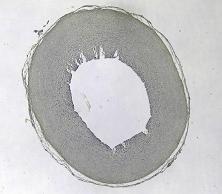
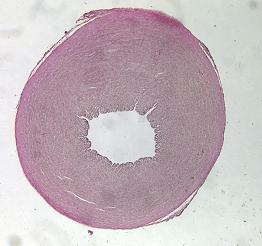
Pictures showing aortas were the bottom picture has an increase in muscle growth in the vessel wall.
This muscle growth in the aortic wall could lead to problems when it comes to regulating blood pressure, due to the fact that the aorta becomes less elastic.
Aim and hypohtesis
The aim of my study is to investigate what effect low oxygen has on the elastic properties of the aortic wall in chicken embryos.
I hypothesis that not only will the chicken embryos developing in a low oxygen environment show an increase in muscle growth in the vessel wall, but this increase will also have an effect on the walls elastic properties.
Methods
I used four different chicken strains two broiler (meat hens) strains Swedish and Dutch, White Leghorn and the red jungle fowl.
The chicken embryos were incubated in two different ways: with normal oxygen, used as a control group, and with low oxygen.
Results
Some results of the study:
- As seen before all embryos for all four strains that had been exposed to low oxygen were smaller then the control animals.
- No difference could be found between the control and low oxygen embryos in the broiler chickens.
- In the White Lehorns the low oxygen ones had a smaller lumen then the controls, but they did not have a larger vessel wall. There might be a simple explanation. Because there is no difference in the size of the vessel wall, and the fact that the low oxygen embryos are generally smaller, might suggest that the reduced lumen in fact are a compensation for a smaller body size.
- The jungle fowl embryos show the complete opposite reaction to what was expected. The low oxygen embryos had a larger lumen and a thinner aortic wall.

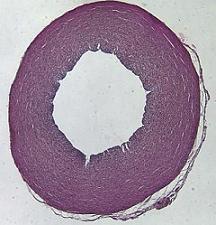
Pictures showing aortas were the one on the bottom has been incubated under low oxygen condition. there were no differens between the control and the ones incubated in low oxygen levels.
Wall elasticity
I also studied the elastic properties of broiler embryos incubated in low oxygen. For this I used so called pressure-diameter loops. Were a certain volume of liquid is injected into the aorta, this will make the vessel expand. The pressure within the vessel is measured and changes in outer vessel diameter are also measured.
These measurements will give an idea of how elastic the vessel is.
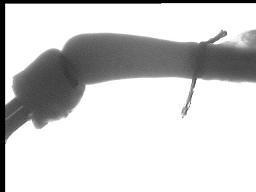
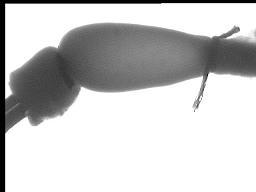
Pictures showing Pressure-diameter loops.
No difference in elasticity could bee seen between the embryos incubated in low oxygen and the control animals.
Conclusion
- No evidence of increased muscle growth in the aortic wall, because of low oxygen, could bee seen in any of the different chicken strains used.
- No changes in elastic properties of the aortic wall was found.
Acknowledgements
Many thanks to my supervisor Dr Jordi Altimiras for his enthusiasm and devotion to the project ,Thomas Östholm for histological consultation and Henrik Gustavsson from Svenska Kläckeribolaget AB in Väderstad for the generous provision of eggs. Tord Jonsson for staining assistance, Marta Diaz for scanning assistance and Pia Ågren for incubating my eggs down in Maastricht. Dr Eduardo Villamor for his hospitality. Martin Andersson, Henrik Bergman, Dr Dane Crossley and Isa Lindgren for there great support.
More information
If you would like this page as a leaflet, see the poster, watch the oral precentation slides or if you want to read more about the project in detail feel free to download the thesis document and the others below.
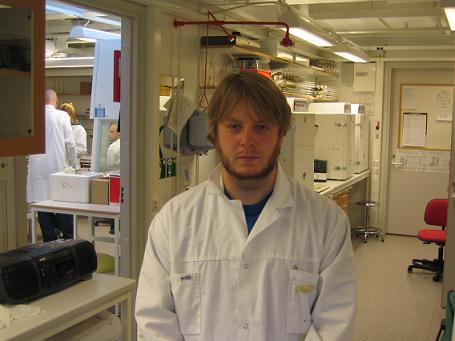
For more information or if you have any questions feel free to e-mail me at: marha698@hotmail.com
Responsible for this page:
Director of undergraduate studies Biology
Last updated:
10/18/05
